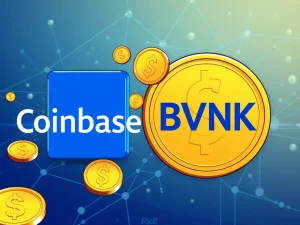Stablecoin Adoption: How Fintechs and Neobanks are Revolutionizing Global Finance

The financial world is rapidly changing. Indeed, a silent revolution is underway, driven by stablecoins and spearheaded by innovative fintechs and neobanks. These digital currencies are transforming how individuals and businesses interact with money. They offer unprecedented opportunities for financial access, especially in underserved regions. This shift marks a pivotal moment, moving beyond traditional banking limitations. Furthermore, it paves the way for a truly inclusive global financial system. This article explores how these modern financial players are accelerating stablecoin adoption and shaping the future of programmable money.
Fintechs and Neobanks: Pioneering Stablecoin Access
Fintechs and neobanks are reshaping the financial landscape. They provide direct pathways to stablecoin access. Traditional banking systems often face economic or operational hurdles in certain markets. Consequently, these challenger systems step in. They offer critical financial services to a broader audience. People and businesses now store stable value in mobile wallets. This helps them navigate economic uncertainties, such as hyperinflation and currency volatility. Furthermore, stablecoins facilitate crucial financial activities. These include remittances, cross-border transactions, credit access, and savings opportunities. Ultimately, users spend their holdings in real time. This comprehensive approach creates a powerful playbook. It truly democratizes financial access and promotes broad-based financial inclusion.
Overcoming Financial Exclusion with Stablecoins
Stablecoins offer a fundamental benefit: financial access. Over a billion adults remain outside the traditional financial system. Stablecoins provide an easy and instant on-ramp to the US dollar. This is especially true in the Global South and emerging markets. Here, they serve as a stable alternative to volatile local currencies. They act as a reliable store of value. Businesses and individuals grappling with currency fluctuations find stablecoins a game-changer. For example, in Argentina, inflation has exceeded 100 percent annually. Small businesses and freelancers increasingly use USDC and USDT. They invoice international clients, pay salaries, and protect earnings. In Latin America alone, stablecoins account for nearly 30% of remittances in specific corridors. Other countries, like Turkey, use USDT as a hedge. This protects against inflation and currency devaluation risks. These fintech stablecoins are bridging critical gaps.
The Power of Earning: Expanding Stablecoin Utility
The stablecoin market cap now exceeds $265 billion. This growth signals the next phase of their evolution: the “earn” proposition. Many fintechs and neobanks integrate blockchain-enabled products. These allow customers to earn rewards on their stablecoin holdings. This capability provides a powerful antidote for those facing high inflation. It also helps those with limited access to traditional savings vehicles. For instance, crypto exchanges often integrate DeFi borrow/lend platforms. They offer these directly into their exchange or non-custodial wallet offerings. This allows users to lend stablecoins and earn a return. Other companies tap into the growing tokenized money market fund ecosystem. These innovations are critical for financial inclusion.
Unlocking Savings and Passive Income
In emerging and developing economies, only a quarter of adults use a savings account. Legacy banking infrastructure often underserves these populations. Now, they can make their money work for them more easily. In Nigeria, Fonbank enables users to convert earnings into dollar-denominated stablecoins. They access onchain savings products. These offer yields far above local bank rates. Such tools preserve value, earn passive income, and bypass local currency devaluation. All these benefits are accessible through a mobile phone. Mobile and global internet penetration continue to rise. Consequently, fintechs have the opportunity to leapfrog certain incumbents. This demonstrates the immense potential of neobanks crypto offerings.
Spending Stablecoins: From Asset to Payment Tool
The ultimate goal for stablecoins is to become a primary medium of exchange. Users would transact without needing to off-ramp into fiat currency. In this “spend” phase, stablecoins transition from a digital asset to a ubiquitous payment tool. Platforms are already making this a reality. They offer stablecoin-backed cards. These allow users to make instant, low-cost cross-border payments. Everyday purchases become simpler. Users tap to pay anywhere Visa is accepted. For emerging and developing markets, this provides a vital solution. It bypasses expensive remittance fees, slow bank transfers, and limited banking access. This fundamentally improves financial inclusion. Some companies even layer on crypto or stablecoin rewards programs. This drives digital adoption and engagement through everyday spending.
The Ubiquity of Programmable Money
This widespread spending capability highlights the true power of programmable money. It moves beyond traditional financial rails. Instead, it offers a more efficient and flexible system. Payments settle quickly and securely. Transaction costs are often significantly lower. This is particularly impactful for micro-payments and international trade. Imagine a future where wages are paid directly in stablecoins. Then, employees instantly use these for daily expenses. This reduces conversion fees and delays. Businesses also benefit from streamlined treasury management. They conduct international transactions with greater ease and transparency. The seamless integration of spending options is crucial for widespread stablecoin adoption.
Beyond the ‘Crypto Casino’: Real-World Utility and Future Growth
A new, efficient, and inclusive financial system is being built. This happens even as global debates around stablecoin classification continue. Fintechs and neobanks are demonstrating stablecoins’ vital role. Their evolving capabilities—to store, earn, and pay—offer net-new assets. They also expand global operations. Stablecoin adoption is a rapidly unfolding reality. It showcases the undeniable value of programmable money beyond mere speculation. In fact, stablecoin transfer volume in 2024 surpassed the combined volumes of Visa and Mastercard. This staggering statistic underscores their growing utility. Once seen primarily as instruments of speculation, stablecoins are becoming far more fundamental. They serve as the backbone for responsible, world-scale digital finance.
Regulatory Landscape and Continued Innovation
The passing of acts like the GENIUS Act indicates growing recognition. Regulators are starting to understand stablecoins’ potential. This legislative progress provides a clearer framework. It fosters further innovation and broader acceptance. As the ecosystem matures, we will likely see more sophisticated offerings. These will integrate fintech stablecoins with traditional financial products. The collaboration between established institutions and agile fintechs will accelerate. This synergy will drive greater liquidity and accessibility. It will also enhance consumer protection. The future of finance increasingly relies on these digital innovations. Ultimately, it promises a more equitable and efficient global economy. This continued evolution positions neobanks crypto services at the forefront of financial innovation.
Opinion by: Morgan Krupetsky, vice president of Onchain Finance at Ava Labs. This article is for general information purposes and is not intended to be and should not be taken as legal or investment advice. The views, thoughts, and opinions expressed here are the author’s alone and do not necessarily reflect or represent the views and opinions of Crypto News Insights.







